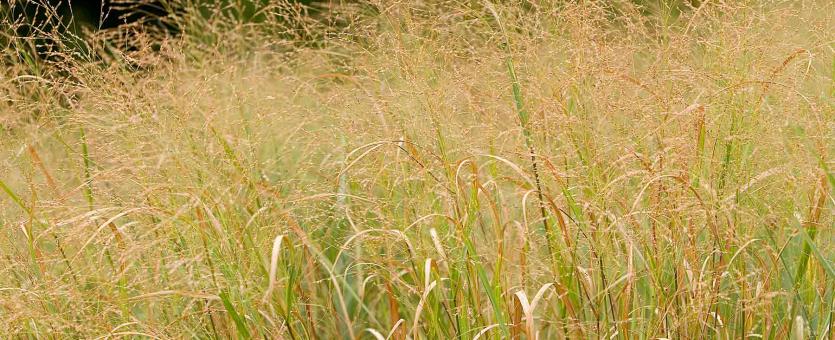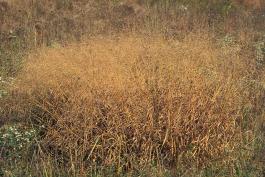
Switchgrass is a native perennial, warm-season, clump- and sod- forming midgrass or tall grass with long-creeping rhizomes. In midsummer, open, multiply-branching flowering clusters rise above the foliage.
The flowering stems are rather stout and stiff and round in cross-section, with leaves scattered along the stems. At the juncture of the leaf blade and the leaf sheath, there is a line or band of hairs 2–4 mm long, sometimes with a very short membrane at the base.
Leaf blades are 6–22 inches long and can be a little over ½ inch wide. These are firm, arched or spreading, bluish green and often somewhat whitish-coated. The margins are sometimes somewhat rolled inward; the midvein is prominent and raised on the undersurface.
Flowering clusters are usually 6–20 inches long, the primary branches ascending to spreading, but not spikelike, rebranching several times in different directions. The spikelets are usually less than ¼ inch long, narrowly oval in outline, narrowed or tapered to a sharp-pointed tip. Flowers June–September.
Sometimes a switchgrass plant will produce normal-looking flowering clusters, but in which none of the spikelets mature. These spikelets do not develop the hardened, shiny look of normal plants and can mislead people trying to identify the grass.
Similar species: Missouri has approximately 11 or 28 species in genus Panicum, generally called panic grasses (17 of the 28 are split away, by many botanists, into a separate genus, Dichanthelium).
Height: flowering stems usually 14–55 inches. Native plants are usually less than 5 feet (60 inches) tall, but more robust strains imported from other regions and used in forage plantings can reach nearly 10 feet tall. Not counting the flowering stems, the clumps of foliage can reach about 3 feet tall.
Common nearly statewide.
Habitat and Conservation
Occurs in bottomland and upland prairies, savannas, calcareous glades, ledges and tops of bluffs, gravel bars and banks of streams and rivers, bottomland forest, and openings of mesic (moist) to dry upland forest. Also occurs on pastures, old fields, roadsides, railroads, levees, and open disturbed areas.
Switchgrass is a characteristic species of tallgrass prairie and dolomite glade natural communities, but it occurs in numerous other habitats.
Status
Native perennial, warm-season, clump- and sod- forming midgrass or tall grass with long-creeping rhizomes.
Human Connections
Switchgrass provides excellent forage and hay for livestock and is an important species for warm-season grass plantings, for example, in mixes with bluestem, Indian grass, and sideoats grama.
Switchgrass is being tested as a possible source of plant material for production of ethanol for fuel.
The species name, virgatum, means twiggy. This might refer to the spreading, rebranching inflorescence branches.
Switchgrass is a native ornamental grass that can be used in sunny rain gardens, as a screen, and in other places where it can naturalize. It tolerates drought and a variety of soils. The flower heads are attractive and can be used in flower arrangements, either cut or dried.
Switchgrass is used to prevent soil erosion, in projects where plants are established in an area to clean toxins out of the soil, in ethanol production, and more. There has been a great deal of research into using switchgrass as a source for ethanol; it is rather inexpensive to grow, once established doesn’t need reseeding, and yields high amounts of ethanol.
Ecosystem Connections
Switchgrass, especially when combined with its natural suite of other native tallgrass plants, offers excellent wildlife forage and cover. Many seed-eating birds, from sparrows to waterfowl to upland gamebirds, as well as mice and other rodents, eat the seeds. The young foliage is food for deer and other hooved grazers.
Switchgrass was an important member of Missouri’s native tallgrass prairie natural community, which once covered more than a third of the state. Only small fragments remain.
We usually think of the environment affecting the organisms that live in it, but it can be the other way around, too. Switchgrass has an extensive root system that can extend 10 feet into the soil. Over thousands of years, it and many other deep-rooted prairie plants built up the rich, deep soils of the American Midwest.
Switchgrass is the preferred larval host plant for an attractive noctuid moth called the pink-streak (Dargida rubripennis). As the name suggests, its cream-colored forewings have pink streaks.
A wide variety of insects feed on switchgrass and its relatives: the caterpillars of many prairie skippers and moths, certain types of fly larvae, true bugs, beetles, grasshoppers, aphids, leafhoppers, and more.

































